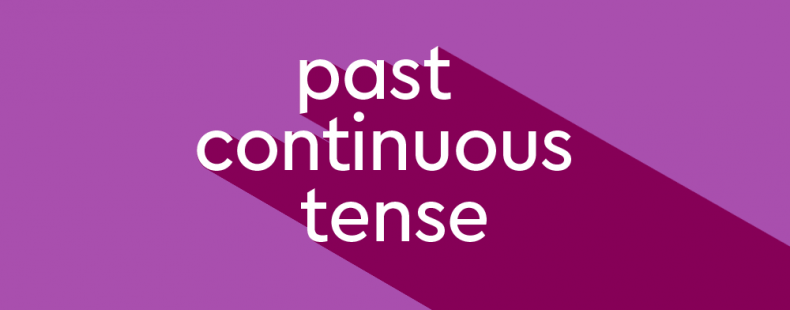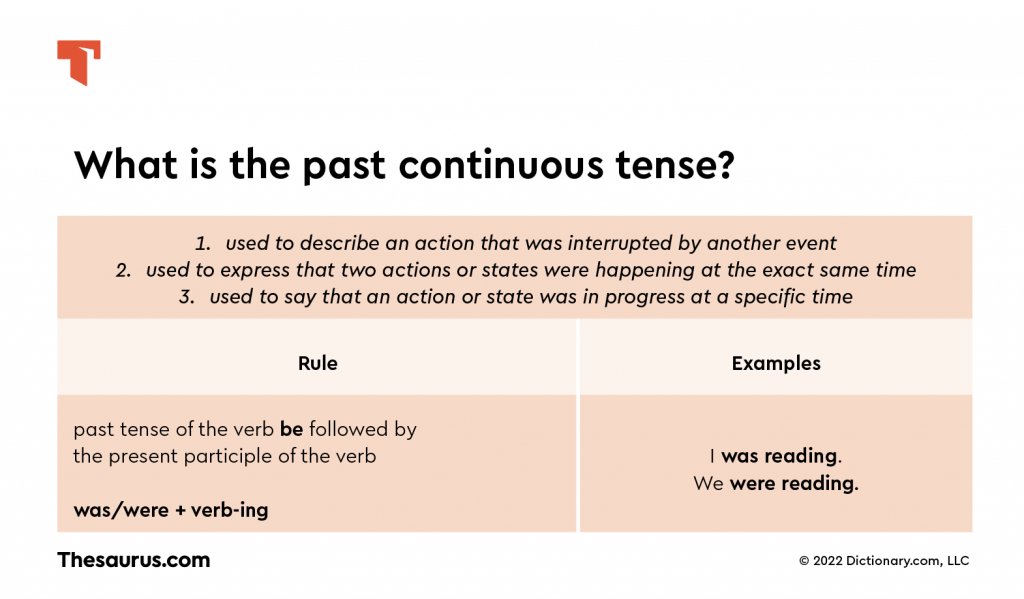Let me tell you about the exciting day I had yesterday. At 8 in the morning, I was eating breakfast with rock stars. For the rest of the day, we were performing music and meeting with fans until the sun set. Sounds like fun, right? The two sentences I used to tell my little story also both showcase a fun way to use verbs in grammar: the past continuous tense.
What is past continuous tense?
Verbs refer to actions or states of being. We use lots of verbs, and they come in many different types of verb tenses. The tense of the verb says when in time something happened or when it was in a certain state. Right now, we are going to look closer at an especially versatile verb tense: the past continuous tense, also known as the past progressive tense.
Like the other two continuous tenses (present and future), the past continuous tense refers to actions or states that were continuous, meaning that they happened over a period of time. This is different from the simple past tense, which often refers to actions or states that specifically started or finished at certain times. For example:
Simple past: I did my homework at 7 o’clock. This sentence means that I started/finished my homework at 7.
Past continuous: I was doing my homework at 7 o’clock. This sentence means that I was in the middle of doing my homework, but I started before 7 and continued doing it after 7.
As you are about to see, the past continuous tense is a useful verb tense that can do a lot of different jobs.
When do you use past continuous?
There are several common ways to use the past continuous tense:
1. One of the most common reasons that we use this tense is to describe an action that was interrupted by another event:
- He was watching the squirrels until they ran away.
- I was minding my own business when the bees swarmed me.
The interrupting event may not actually be stated in the sentence:
- Natalie was reading books until midnight. (Natalie probably decided to go to bed.)
2. Another reason we use the past continuous tense is to express that two actions or states were happening at the exact same time:
- We were telling ghost stories while spooky music played.
- I was listening to “A Way With Words” while you were playing with the dog.
3. As alluded to earlier, we also use the past continuous tense to say that an action or state was in progress at a specific time:
- At sunset, Mike was walking in the park.
- At noon, I was eating lunch with my friends.
In general, we don’t usually use verbs acting as stative verbs in the past continuous tense. Generally speaking, stative verbs (such as like, want, or believe) express states or conditions, so it would be odd to describe these things as being “in progress.” When dealing with stative verbs, we typically use the simple past tense instead.
For instance, we are much more likely to say I was asleep when Heather called rather than I was being asleep when Heather called. Sometimes a verb can be either a stative or a nonstative verb, depending on context or meaning. This is the reason why you may hear the sentence He was looking at paintings yesterday but are much less likely to hear the sentence The plants were looking dead yesterday.
How to form past continuous tense
In order to form the past continuous tense, we use the past tense of the verb be followed by the present participle of the verb. The present participle is a form of a verb that ends in the suffix -ing. For example, the present participle of read is reading. When using the past continuous tense, the verb be must be correctly conjugated to match the subject. For example:
- I was reading
- You were reading
- He/she/it was reading
- We were reading
- You were reading
- They were reading
When using the past continuous tense, the verb be must agree with the subject. Here are examples of sentences using the past continuous tense. Notice that the verb be is correctly conjugated to agree with the subject.
- I was making a sandcastle when the huge wave crashed into me.
- Sarah was playing guitar while Dominic was playing the drums.
- The seals were performing tricks when we visited the zoo.
- I was napping outside while they were looking for me in the house.
How to make past continuous tense negative
In order to make the past continuous tense negative, all you need to do is put the word not after the verb be:
- I was not goofing off during the field trip.
- He was not paying attention when he walked into a tree.
- Luckily, we were not skiing when the avalanche occurred.
- The accident happened because the workers were not practicing proper safety.
All the verbs, none of the errors
You won’t mistake your verb tenses again when you check your writing on Thesaurus.com’s Grammar Coach™. This writing tool uses machine learning technology uniquely designed to catch grammar and spelling errors. Its Synonym Swap will find the best nouns, adjectives, and more to help say what you really mean, guiding you toward clearer, stronger, writing.
Whether you’re writing about the past, present, or future, start writing smarter today!















